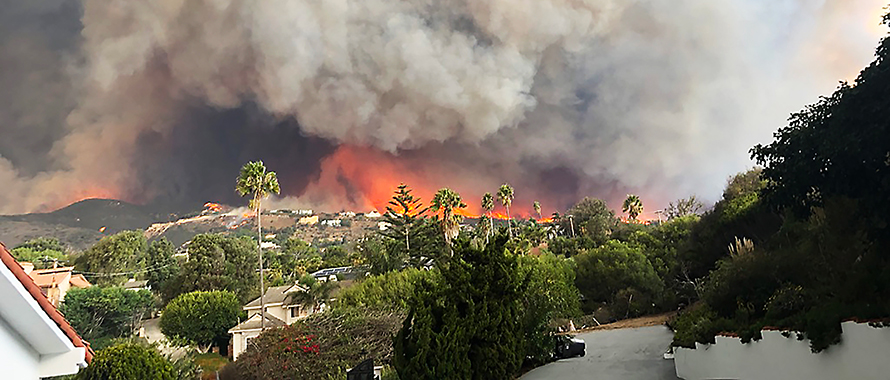The latest blazes contribute to an already devastating year for wildfires that saw 3 million acres burned so far compared to 2.1 million acres during the same time period in 2020, CNN reported. Severe heat and dry conditions heighten the risk of additional fires, officials said.
That risk is continually rising due in part to drought and climate change, said Pamela Alphabet, Regional Practice Group Leader, Personal Insurance, Burns & Wilcox, Scottsdale, Arizona.
“Wildfire risk continues to increase each year, year over year,” she said. “Conditions are getting dryer—and dry vegetation continues to persist. As we can now see, it is not just California; a lot of the Western states are experiencing more wildfires, as well.”
The environmental and vegetation conditions in California that contributed to last year’s record-breaking wildfire season have not changed, said Nick Lauria, Chief Fire Operations Officer, Wildfire Defense Systems, in a recent Burns & Wilcox webinar.
“[As far as] its propensity to burn, ignite, cause damage, and become a large scale fire quickly—nothing has changed in a year. We are facing the same situation,” he said. “We anticipate that this year will be very much like last year, or it could be worse. That is the reality we face.”
Lack of insurance can leave homeowners vulnerable to major losses
Homeowners Insurance usually covers losses related to wildfires, but property owners in areas of high wildfire risk may have trouble finding coverage. Many farm owners in California have raised the alarm over the issue, citing rising rates and non-renewals, for example.1 The California Fair Access to Insurance Requirements (FAIR) Plan, which was expanded on July 23 to insure certain farm and ranch properties, can provide a stripped-down type of wildfire coverage. In other high-risk states, however, property owners may not have any options at all.
“Idaho is the state with the highest number of large fires right now, and they do not have a plan where they can go to the state for assistance with insurance to cover fires,” Alphabet said, adding that this may change in the future as wildfire risk rises and more homeowners are left without coverage.

Wildfire risk continues to increase each year, year over year. … It is not just California; a lot of the Western states are experiencing more wildfires, as well.
Homeowners Insurance and wildfire coverage is typically an “all or nothing” situation, Alphabet said, with many insurance carriers pulling out of certain states or ZIP codes completely rather than excluding wildfire risk.2 “It is pretty rare to find a wildfire exclusion,” she said. “If the wildfire risk continues, insurance carriers pull out of the state and it just becomes more and more difficult. The options that are left may provide less coverage or charge higher prices.”
Homeowners in higher-risk areas who are able to access Homeowners Insurance may find rates exceedingly high or with separate wildfire deductibles, for example. These homeowners could be at risk for forgoing insurance due to cost, while others could have force-placed insurance imposed by their mortgage company and ultimately face foreclosure if they cannot pay for it.3
In Malden, Washington, where a 2020 wildfire destroyed 80% of the town, only about 40% of structures in the city were covered by insurance, the Spokesman-Review reported.4,5 Some homeowners who did have Homeowners Insurance found that they were underinsured because they did not have coverage for full replacement value.
“If somebody cut corners and insured the home for less, they will not get the dollar amount they thought,” Alphabet said. “You need to make sure that your home is insured to value.”
Evacuation, living expenses and smoke damage among top wildfire expenses
During the 2020 wildfire season, hundreds of thousands of residents across the U.S. were forced to evacuate their homes for varying lengths of time.6 In Canada, evacuations for wildland fires increased between 1980 and 2018 and are expected to rise as climate change makes wildfires more common, Canadian authorities report.7
Evacuation and temporary living expenses are some of the most common costs faced by those impacted by a wildfire. This may include transportation, lodging, and food while the homeowner is displaced. These expenses can be covered by Homeowners Insurance, Alphabet said, but it is important to check with your insurance broker to ensure this is included.

We anticipate that this year will be very much like last year, or it could be worse. That is the reality we face.
“In many cases, it is quite a while before the homeowner is getting back into their home,” she explained, pointing to the Tamarack fire south of Lake Tahoe, California, for example, that raged for almost a month and is now 82% contained.8,9 “That is almost a month already and it has not even been 100% contained. With wildfires, homeowners could be out of their home for months, a year or even a couple of years, depending on the extent of the damage and what it entails to rebuild the home.”
Without insurance, “it could be devastating to them,” Alphabet noted.
In 2020, wildfires across the U.S. West led to losses costing insurance companies up to $13 billion, Reuters reported late last year.10 Beyond the immediate expenses of evacuation and temporary lodging, one of the most misunderstood aspects of wildfire risk is the damage that smoke can do to a home.
“If fire does not hit your home, smoke might. Total devastation does happen on occasion, but if it does not take our home, smoke is often the number one issue,” Alphabet said, noting that even this type of damage will often require moving out while repairs take place. “Homeowners may need to leave and find other lodging, so that is a big expense.”
Total destruction is also possible. In British Columbia, a July wildfire quickly ripped through the village of Lytton and destroyed multiple structures and homes, leaving almost “nothing left.”11 In Oregon, where the Bootleg Fire has destroyed 161 homes, one resident who lost his home to the fire said it “looked like an atomic bomb” had hit.12
Unfortunately, Lauria added, current conditions mean homeowners face “compounding factors that essentially result in more fires, larger risks, and more risk to homeowners,” he said. “[Homeowners] are not as safe as they were 30 years ago.”
Homeowners should avoid flammable building materials, work with specialized broker
According to the National Fire Protection Association, the conditions surrounding a home can impact how vulnerable it is to wildfire.13 Homeowners are advised to keep roofs and gutters clear of flammable debris, repair loose shingles, and move any flammable materials away from the home’s exterior, such as mulch, flammable plants and firewood piles. Homeowners in areas at high risk for wildfires should avoid wood roofs and other flammable building materials, Alphabet added.
“Being more thoughtful as to what type of building materials they are using is important,” she said.
Some insurance carriers may offer programs to help homeowners limit their risk in advance of a wildfire. Burns & Wilcox, for example, has a partnership with Wildfire Defense Systems that provides protection and risk management services for homeowners. This is included in Burns & Wilcox Homeowners Insurance policies in California, Oregon, Washington, Idaho, Montana, Wyoming, Utah, Nevada, Arizona, and Colorado, she said.

You definitely need a broker who is familiar with the local area, understands the market, and can customize a program that is best-suited to these homeowners.
In addition to preventative services like moving flammables or boarding up a home, Wildfire Defense Systems also works in conjunction with local fire departments in responding to wildfires. In 2020, Wildfire Defense Systems monitored 12,552 wildfires in the United States, made hundreds of home visits and directly saved six insured homes from burning down.
“They are going to check on the property and if something needs to be cleared, like woodpiles, they will take care of that,” Alphabet said. “They are an additional set of experienced eyes and ears that can take care of the home when you are not able to. They have that expertise. They also come out with your local firefighters, and that offers some additional resources that could help save your home or mitigate potential damage.”
The tactics to protect a home must be comprehensive, Lauria emphasized. The first 5 feet around a home are the most critical, he said. Non-combustible siding and deck materials are a prime example. “Things like that are what is going to save homes, and that is what [homeowners] can do to protect themselves,” he said.
When it comes to finding Homeowners Insurance that will address the risk of wildfires, it is best to work with a broker who is knowledgeable about this specific threat. In addition, “make sure to research the financial rating of your insurance company,” she recommended. “You do not want an unrated insurance carrier that is stepping into a marketplace they are not experienced with.”
As the risk of wildfires continues to grow, having the right insurance coverage will only become more essential.
“It is the new normal,” Alphabet said. “I do not see costs going down, and that will make it harder for some individuals. You definitely need a broker who is familiar with the local area, understands the market, and can customize a program that is best-suited to these homeowners.”
References 1Vittek, Shelby. “California Farmers Struggle to Secure Wildfire Insurance Coverage.” Modern Farmer, August 2, 2021. 2Kasler, Dale. "Insurance companies abandoning California at a faster rate, as wildfires wreak havoc." Sacramento Bee, October 19, 2020. 3Kagan, Julia. “Force-Placed Insurance.” Investopedia, June 11, 2021. 4Katkov, Mark; and Chappell, Bill. “Fast-Moving Wildfire Destroys 80% Of Small Town In Eastern Washington State.” NPR, September 8, 2020. 5Epperly, Emma. “‘Highly unique’ circumstances led to lack of insurance coverage for most Malden residents.” The Spokesman-Review, May 6, 2021. 6Bacon, John; Hughes, Trevor; and Ortiz, Jorge L. “'War zone': Deadly wildfires rage in Western states: Death toll rises as hundreds of thousands evacuate.” USA Today, September 10, 2020. 7Government of Canada. “Wildland fire evacuations.” July 15, 2020. 8Staff Report. “Tamarack Fire management changes hands with blaze mostly contained.” Tahoe Daily Tribune, August 3, 2021. 9Miles, Anisca. “Tamarack Fire containment grows to 82%, acreage remains the same.” Fox 40 News, August 2, 2021. 10Lavietes, Matthew. “Western U.S. wildfires cost insurers up to $13 billion in 2020.” Reuters, December 15, 2020. 11Burston, Cole; and Cecco, Leyland. “‘There’s nothing left in Lytton’: the Canadian village destroyed by wildfire – picture essay.” The Guardian, July 25, 2021. 12Olmos, Sergio. “‘It Looked Like an Atomic Bomb’: Surveying the Bootleg Fire’s Devastation.” The New York Times, August 1, 2021. 13National Fire Protection Association. “Preparing homes for wildfire.”





